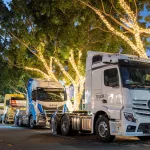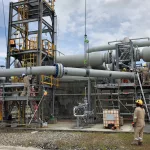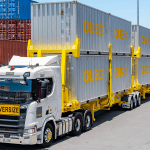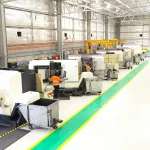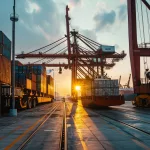The first ever China International Import Expo (CIIE) to be held in Shanghai later this year signifies a turn in the economic tide regarding the country’s approach towards international trade and wider globalisation.
Set to take place between 5-10 November at the National Exhibition Center in Shanghai, welcoming more than 200 Fortune 500 firms and 2,800 global businesses, the Expo is expected to reflect the alterations being made to China’s trade strategy that has historically heavily relied upon exports.
“Hosting CIIE is an effort by the Chinese government to create an open platform where nations and companies from around the world can introduce themselves to the vast Chinese market and explore opportunities for local cooperation,” said Sun Chenghai, Deputy Director General of CIIE Bureau, speaking in January ahead of the conference.
The event countdown has well and truly begun having been announced in May 2017 by Chinese President Xi Jinping during the Belt and Road Forum for International Cooperation. However, it has been the announcements made by the Chinese government in the months leading up to the conference that have provided a real flavour for what this could all mean on the global stage for years to come.
Most interestingly, in April 2018 the National Development and Reform Commission (NDRC), the country’s leading body for economic planning, outlined a five-year timeline for the automotive sector.
- See the latest edition of Asia Outlook magazine here
- Q&A: Why entrepreneurs should look to Hong Kong
- Fuelling China’s growth
This stated that the Chinese government would begin to relax its foreign ownership limits within the industry, lifting restrictions on electric vehicles (EVs) by the end of 2018, on commercial vehicles in 2020, and on passenger cars in 2022.
Further, in June the organisation also revealed that it would begin to ease the difficulties surrounding foreign investment across a range of key sectors from banking, to agricultural, to automotive, whilst last month the government simultaneously reduced import tariffs to 15 percent, down from 25 percent.
DRIVING INNOVATION
Analysts are rightly viewing these announcements as part of a wider policy change within China, as the government is now actively attempting to attract some of the world’s largest companies to the idea of directly setting up shop there.
One such example is evident within the NRDC’s five-year plan, as it claims that it plans to scrap existing legislation that prevents foreign automakers from establishing more than two joint ventures with local companies by 2022.
As a result, Tesla last month committed to building its first EV factory in Shanghai, a facility that is expected to produce more than 500,000 models per year.
Further, Ford revealed in June that it would be selecting China ahead of the US and Mexico as the preferred location to produce its latest generation of the world-renowned Focus, saving approximately $1 billion annually as a result.
By incentivising global names, competition within China’s domestic auto manufacturing industry is likely to rise, ultimately leading to the escalation of R&D and an upswing in innovation, in turn bolstering the country’s Made in China 2025 initiative.
This outlook aims to make China a global leader in the development, advancement and showcasing of the latest technologies, an idea that goes hand in hand with the auto manufacturing as technology continues to sweep through the industry, from exploration into new fuel storage systems to advanced autonomous driving capabilities.
In fact, one of the key goals of Made in China 2025 is to accelerate R&D across the country to better reduce the company’s dependence upon imported oil – a key reason behind the emphasis being placed on EV development.
WEIGHING UP THE FACTORS
Although this all sounds relatively simple, there are many components at play that may not make this transformation as straight forward as it seems, partially due to the remaining restrictions that will maintain the apathetical orientation of many automotive companies towards the Chinese market.
Whilst the NRDC’s plans are set to largely benefit companies like Tesla which are already heavily involved in the EV manufacturing market, those more attuned to producing passenger and commercial vehicles may not consider entering China as a possibility for the next five years.
Additionally, in the longer term, China is aiming for EVs to constitute 20 percent of all vehicle sales across the country by 2025, with the market forecast to grow at almost 53% year-on-year.
Further, Bloomberg New Energy forecasts that EV sales will increase to 11 million worldwide in 2025, 30 million 2030 and 60 million by 2040 as manufacturing costs continue to fall, technologies improve, and global supporting infrastructure networks grow.
With such an outlook, it is unlikely that the passenger vehicle market offers long term prosperity for new investors and market entrants.
Other existing market entry and investment requirements, alongside regulations on manufacturers and products, will also remain in place, creating certain barriers to trade freedoms within the country.
One example of this is that although China is cutting the import tariffs on 79 auto parts to six percent, down from eight-25 percent, this is still double the EU levels of just three percent.
Moreover, the ongoing uncertainty surrounding the ongoing trade war between China and the US under President Donald Trump’s administration is only likely to inhibit an influx of new market entrants due to the uncertainty surrounding the current global economic climate.
Taking these elements in to account, it is unlikely that the quickfire announcements being made by the Chinese government are going to immediately spark the Chinese automotive industry to life through significant foreign investment.
HOW WILL CHINESE COMPANIES FARE?
Although it seems that any major transition within China is likely to happen at a gradual pace, fears remain that the sudden appearance of some of the world’s largest automakers will undermine local automakers through their superior R&D and technological capabilities.
However, the slow process ahead is likely to ensure that this does not happen.
Although firms such as Tesla will have an immediate advantage, many Chinese local brands are well established across the country, and electric vehicle sales currently make up just 2.2 percent of the entire Chinese market.
Furthermore, Chinese manufacturing capabilities have improved drastically in the past two centuries, now coming to rival some of the biggest brands across the US and the EU.
In 2000, Chinese-produced vehicles were found to have 834 problems per 100 vehicles, according a report from global market research company JD Power. However, the same report revealed in 2017 just 112 problems in Chinese vehicles per 100, just 13 points higher than the average found in mass-produced cars in foreign markets.
Consequently, it is unlikely that Chinese brands will suffer heavily off the back of these policy changes, whilst the benefits that they will gradually bring to China in the way of technological, environmental and economic progress will heavily outweigh any setbacks in the form of greater innovation, R&D and accelerated advancements.
This, of course, could change if the Chinese government continues to incentivise foreign car owners, but for now it will be interesting to see how the CIIE conference and the government’s new approach to international trade unfolds later this year, something we will follow up on in the October and November issues of Asia Outlook magazine.




